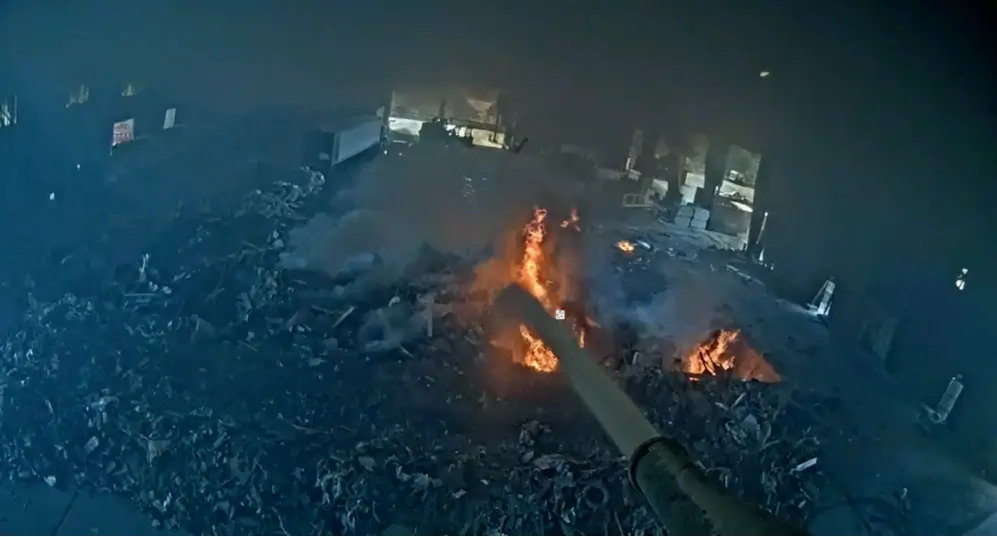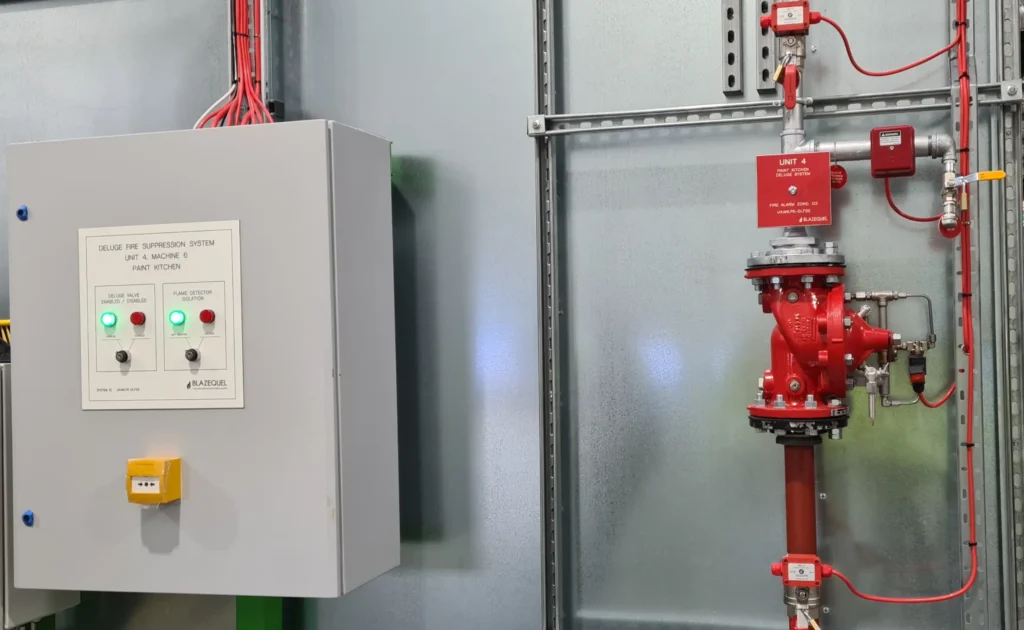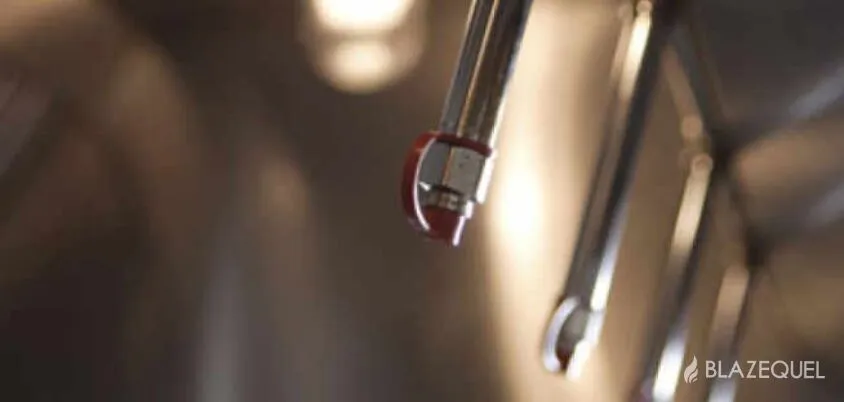
AUTOMATIC WATER CANNON SYSTEM
Water Cannon
Fire Suppression Systems
Blazequel, is a leading provider of fire protection solutions for high-risk industries such as waste recycling in the UK and Ireland.
We offer comprehensive services for automatic water cannon systems, from design and installation to inspection, maintenance, and repair for automatic water cannon systems. Get in touch with us today to explore how we can safeguard your business from the threat of fire.
What is an Automatic Water Cannon Fire Suppression System?
An Automatic water cannon systems are designed to automatically detect and extinguish fires, particularly in high-risk industrial environments such as waste recycling, chemical plants, factories, and refineries.
Water Cannon systems integrate innovative fire detection technologies with advanced robotic nozzles to produce the world’s quickest responding, completely or semi-automated firefighting robots. These units can deliver fire suppression using water or foam.
How does a Water Cannon Fire Suppression System Work?
The system typically consists of a network of water cannons also known as monitors strategically placed throughout the facility. These cannons are equipped with a fire detection system which is appropriate for the environment.
When a fire is detected, it sends alarm signals and activates the cannon. The cannon will then discharge a jet of water or foam onto the fire suppressing it and preventing its spread.
Operators can also control the cannon manually.
Water cannons are often used in conjunction with other fire protection measures, such as thermal fire detection, sprinkler systems, and fire alarms to provide comprehensive fire safety coverage. They are particularly useful in areas where ‘traditional’ fire suppression systems such as deluge systems may be inappropriate due to the nature of the fire hazard, the type of storage layout and the firefighting strategy required (like for example, in the recycling industry).
Water Cannons generally deliver with a throw length of between 30-75 metres.
Benefits and drawbacks using automatic water cannon systems
Pro's
- Automatic water cannon systems can sometimes work out to be a substantially lower cost than fire sprinkler/deluge systems.
- As a single water cannon can protect a very large area, the amount of engineering required in your system is significantly lower than when installing a sprinkler system or deluge system. This reduces disruption to your operations – particularly for retro-fit applications.
- A targeted water cannon(s) can deliver more water to the area at risk at a higher pressure than sprinkler/deluge systems. This will increase its effectiveness in dealing with deep-seated fires and hotspots, whilst reducing overall water usage and minimizing collateral damage as a result of the fire.
- When using early detection such as thermal imaging or video smoke detection to detect signs of fire or a developing hotspot, the system is proactive (looking for early signs of a developing fire and raising early warnings) as well as reactive (detecting a genuine fire event and commencing automatic suppression) – a massive improvement on traditional fixed systems.
- The water cannon can be remotely controlled using a joystick if required, which will help site operators or the fire service fight the fire from a safe distance in the event of a large fire incident.
Con's
- A thermal imaging system will also be invaluable in a large fire incident in allowing the fire service to get a proper understanding of the risk (even through smoke and steam), to ensure they can deal with it quickly and safely.
- Consideration is required for the type of waste being processed to ensure that the force of the water cannon does not spread the burning materials. For example, this can be a particular concern when protecting loose SRF (Solid Recovered Fuel) where the velocity of the water jet and the air turbulence created by discharging the cannon could blow materials into the air if the cannon is not used with care.
- As the water cannons will provide targeted protection, rather than blanket protection (as with deluge system) it may not be so effective at tackling a fast-moving surface fire.
- Water cannon systems provide directional coverage. The water stream from the cannon will obviously not bend around walls and corners! Therefore, if your process has a lot of walls or obstructions, careful design consideration is required to ensure full coverage of the required risk areas.
- Water cannon systems are generally custom-engineered for each specific application. This may mean that certain insurers will not accept the systems, or will want them to be combined with traditional technologies (such as sprinkler systems). We’re familiar with working with many insurers, who have approved our water cannon systems in various applications.
Different Types of Water Cannon System
Water driven oscillating water cannons (zoned protection)
Oscillating water cannons are activated by opening the control valve and allowing water to flow through the Cannon. As water flows through the Cannon a small percentage of the water is used to drive a hydraulic motor which moves the cannon from left to right on a fixed axis.
The Cannon only moves on the horizontal axis (there is no vertical movement). As a result of this you get a small blind spot below the cannon which sometimes needs to be protected by additional spray nozzles. You can see this in the video of our oscillating water cannons protecting a waste transfer station.
Generally oscillating water cannons cannot be used for manual control, as they are often installed in inaccessible locations. Furthermore, manual control requires an operator to stand behind the cannon and manipulate it. This may be unsafe in a smoky environment, close to a fire.
Oscillating cannons are great for drenching a large area swiftly, but ineffective at targeting and extinguishing a deep-seated fire. They also tend to use a lot of water, as we need multiple cannons operating simultaneously to efficiently cover an area.
Electrically operated cannons have three small motors which control movement on the horizontal and vertical axis and also adjusts the nozzle position between a jet and a fog. Control and operation of these motors by a PLC (programmable logic controller), therefore allows the Cannon system to be manipulated automatically, or remotely.
Often, an electrically operated Cannon is combined with a zoned programme. The risk area is broken into multiple fire zones and a separate zone area is programmed in the PLC for each of these risk areas. A detection system (generally using flame or thermal fire detection) is then utilised to provide an alarm into the PLC, commanding the cannon to operate over that specified zone.
The automatic operation can be overridden via manual control, typically from the PLC control panel or via a remote handheld controller which allows wireless operation of the of the camera.
Electrically driven oscillating water cannons (zoned protection)
Electrically driven self-targeted water cannons (targeted protection)
Self-targeted water cannons such as our Fire Rover system provide the optimal level of fire detection and suppression in complex environments. When a fire is detected the remote operator controls and directs the cannon – ensuring the spray hits the specific area in which a fire has been identified. This ensures efficient use of water and minimizes water runoff and pollution issues.
The presence of the remote human operator also ensures the safety of your site operatives, as there is always a risk of a site operative entering the risk zone and otherwise being struck by the water stream from the water cannon (this could be very dangerous due to the operating flow and pressure of the water cannon).
Furthermore, the remote human operator provides a detection and suppression system with unrivalled sensitivity, yet also eliminates false alarms and thus, false discharges of the cannon system. Our Fire Rover system combines thermal fire detection, video smoke detection, and flame detection into a single system, whilst the human alarm filtering prevents false alarms from normal operations from causing site disruption and discharge of the cannons.

Frequently Asked Questions
What types of fires are automatic water cannon systems effective against?
Water cannons are effective against various types of fires, but primarily are used for Class A (ordinary combustibles such as wood, paper, and fabric). where these materials are stored or processed in bulk creating a potential significant fire load.
Are water cannons used with foam?
Yes, depending on the nature of your fire risk we may recommend the use of a foam or ‘wetting agent’ to facilitate suppression. Wetting agents (also knowns as a surfactant) reduce the surface tension of the water, improving penetration into Class A fire materials. This in turn can provide faster suppression and reduce water requirements.
What are the factors to consider when installing an automatic water cannon fire suppression system?
You must consider building layout, fire risks, water supply, power, control systems, maintenance accessibility, environmental factors, compliance, and training.
Strategic cannon placement, reliable supplies, and thorough training ensure system effectiveness. Compliance and regular maintenance guarantee operational readiness, meeting safety standards. Contact us for assistance.
Are automatic water cannon systems environmentally friendly?
Water cannon systems can use significantly less water than sprinkler or deluge systems, helping to prevent water run-off and pollution issues. Particularly when using targeted water cannons, the water is discharged accurately onto the specified area of risk (which improves suppression efficiency and reduces the required duration of the cannons operation).
What is the range and coverage area of the water cannon?
The range of a water cannon system is derived from its discharge flow and pressure. As mentioned above, a cannon system can typically throw from 30-75m, so long as it has a clear line of throw with no obstructions. For the spray range described above, low rates can range from 950lt/minute to 4500lt/minute!
Are there any regulatory requirements or standards that govern the installation and operation of automatic water cannon systems?
There are a few standards (mainly American NFPA standards) which are used for the design of water cannon systems, but there is little real guidance for these systems. Each water cannon installation is very application specific.
Furthermore, different insurance companies have different rules and opinions. In short – for water cannon systems, there is very little regulation and a lack of joined-up thinking across the market! Using the recycling sector as an example, this creates a risk that you could buy a system which would be approved by the insurer, but not accepted by the Environment Agency (or vice versa). That’s why it’s really important to engage these stakeholders in advance, and to speak to a fire protection advisor who you can trust to ensure you get a finished solution that meets your needs.
Are automatic water cannon systems suitable for indoor and outdoor use?
Yes, at Blazequel we have installed cannons systems both indoors and outdoors. One of the challenges of outdoor fire suppression is that wind interference can considerably reduce the reach of your water jet, which needs to be considered in the design. External cannons can be mounted on either a building structure or a custom-built tower/column.
Are you ready to prioritize safety?
Don’t hesitate to reach out to us, or you can easily fill out the form below. We’re here to assist you.
- +44 (0)1234 357357 - UK Head Office
- +44 (0)1234 377775 - Northern Ireland Office
- sales@blazequel.com

You May Also Like

Fire Sprinkler Systems
Fire Sprinkler systems are a very effective and reliable way to protect almost any building or asset from fire. They

Deluge Systems
brilliant solution for high-risk areas, where the sometimes-slow reaction speed of sprinkler systems will allow too long for the fire

Kitchen Fire Suppression System
industrial kitchen fires need quick attention to prevent them spreading to ventilation ducts. An Automatic Kitchen Fire Suppression System ensures
